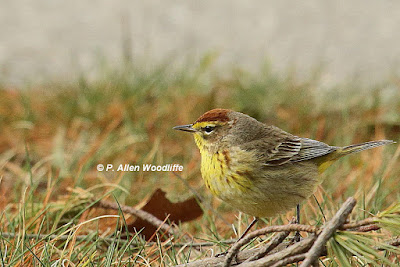Yellow-rumped Warblers have been the most numerous, as expected. Some are fairly drab, not yet having attained their breeding plumage.
More and more are looking quite dapper.
I had my first Palm Warbler a couple of days ago. It was hanging around an open grassy area with several dozen Chipping Sparrows, as well as an ongoing Clay-colored Sparrow and a few Field Sparrows.
 |
| Palm Warbler |
 |
| Clay-colored Sparrow |
 |
| Field Sparrow |
Hermit Thrushes are quite common.....
....but certainly are not the most common of the thrush family. That honour currently belongs to the American Robin.
Brown Creepers are a lot more common these days, but their small size and cryptic coloration makes them difficult to see.
The great thing about this time of year is that if the birds are few and far between, the wildflowers are showing well, so there is always something to see.
 |
| Spicebush |
While it was nice to see here, I was fortunate to have seen dozens last July while travelling through southern Saskatchewan and Manitoba, and was also fortunate to have been able to get some fairly good photos of them in prime breeding plumage.
While we were at Erieau watching this grebe, a young Glaucous Gull was observed resting on the far breakwall. Its very large size and almost pure white colour really makes it stand out amongst the gulls.
The gulls got up and were flying around when all of a sudden we noticed about a dozen Willets flying in and landing on the armourstone surrounding the fish tug harbour. While at rest, they blended in really well against the colour and pattern of the armourstone, and initially we thought there were only 11. A closer look at the photo showed an even dozen.
The Erieau Rail trail hasn't been terribly productive lately, although there are always a few things to look at. Certainly the Wood Duck nesting box leaves a lot to be desired as a nesting feature, unless the ducks want one with an indoor swimming pool. I doubt it came with a sump pump, a feature I am glad to have at our place these days.
On the occasional sunny day, Painted Turtles will be out, soaking up some hard-to-come-by sunshine.
After leaving Erieau, I headed to the park. There wasn't much new to add to recent visits. I did stop at the Keith McLean Conservation Lands, as with the high water levels, portions of the fields are flooded, making it attractive to gulls and shorebirds. Steve C had seen about 27 Willets there yesterday. The smallest flooded area is visible from the road, but the better area for gulls and shorebirds is not. One has to walk along the very muddy edge of the trail (the trail itself was partially under water in places) to the bridge and just before crossing it, follow along the creek downstream. It paid off on this occasion. Several folks that I had talked to earlier indicated the Willets were not present, and not much else was either. But on my visit, I came across a couple of Lesser Yellowlegs and at least three Greater Yellowlegs, both expected species. However there were also two Willets, and I was able to get some fairly good photos, which were much better than the ones I got earlier at Erieau.
Gulls were noticeable by their absence on this visit. For some reason there was only this one Bonaparte's Gull at this spot, and there must have been something less than 100% about it, as it let me approach quite closely and never moved. Perhaps exhaustion, or perhaps ate something that didn't agree with it. Who knows...
There are always Red-winged Blackbirds about the wetland edges.
On Sunday afternoon, I decided to check out the Fletcher Ponds, between Merlin and Tilbury. It isn't a large area, but is kind of an oasis in the middle of extensive agricultural fields, so with the various ponds, shrubby areas and larger trees, you never know what might drop in. If you want to know a little more about the Fletcher Ponds, check out my blog post of about a year ago. It doesn't take a long time to walk the trail and see what was there, and on this day there wasn't a lot. However I did see a few species and heard several Chorus Frogs. And I got my first Ring-necked Ducks there.
In just a couple of days, the month of May arrives. Over about a three week period, there will be a major influx of birders to southwestern Ontario, especially at places as well known for birds as Rondeau. Hopefully the birds will greatly outnumber the birders but there may be some days when they don't. It is always interesting to see the many people who arrive. Some of them you see annually at this time and are easily recognizable. Others will be new; perhaps it will be their first of many future trips to the park. And while some faces are well remembered from past years, others will not be, and have you stumped.























































